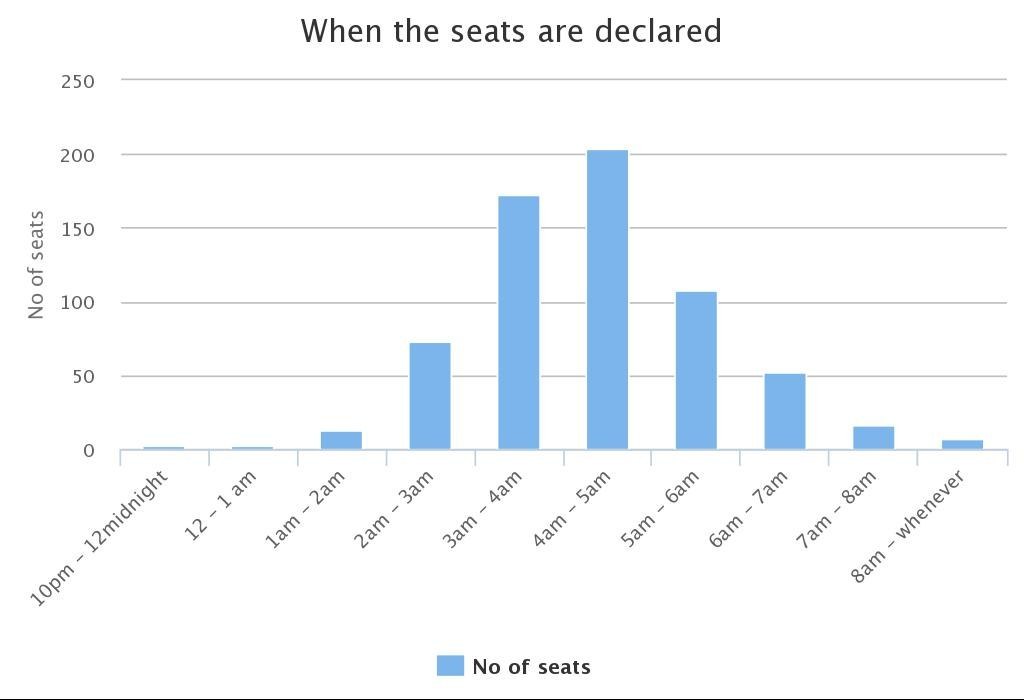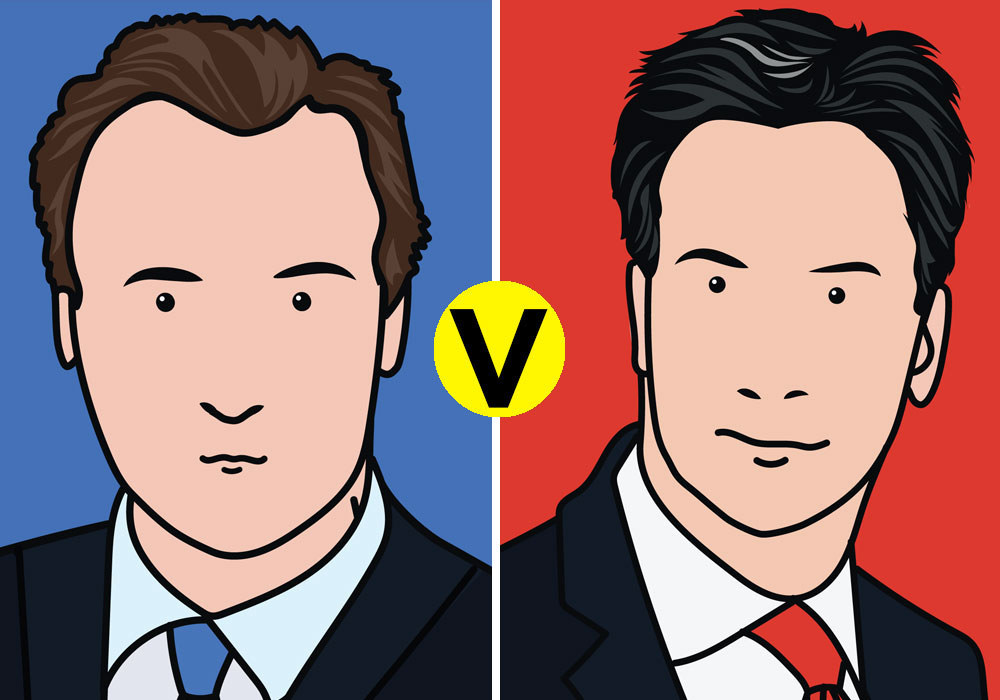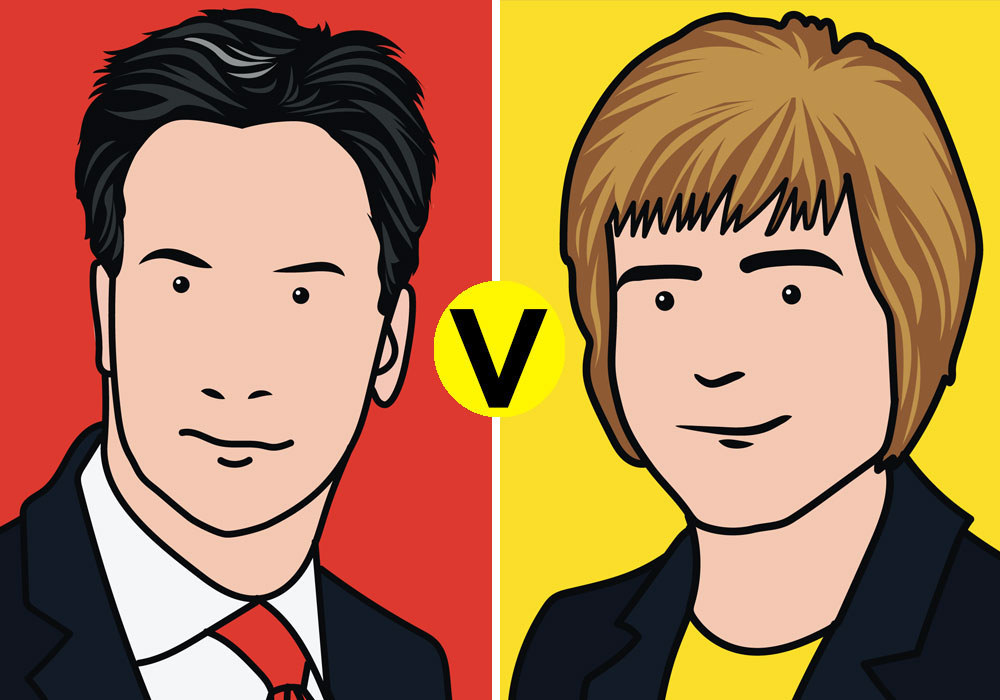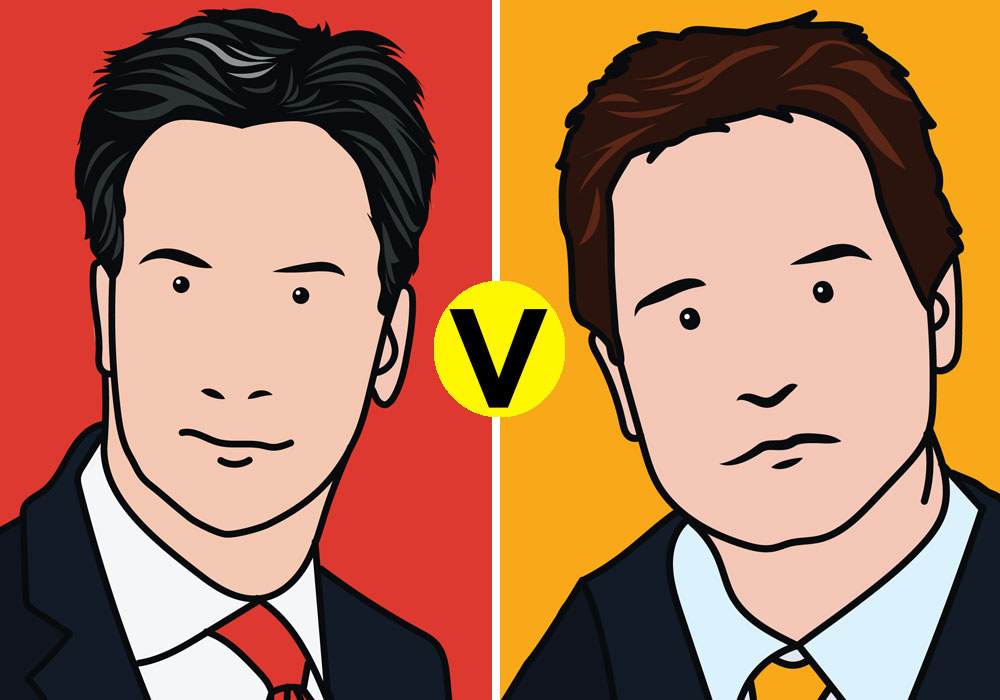
General elections used to be simple. One night, 650-odd seats, two big parties, one clear winner.
Sometimes there was a little bit of drama over particular seats, or how large the government's exact majority would be. But generally, once the polls closed at 10pm and the exit polls appeared, you pretty much knew who was going to be in Downing Street for the next few years.
But now, things are a bit more chaotic.
You still have the same number of seats, and David Dimbleby's still there on the telly to oversee proceedings, but the more basic question of who's actually won is rather harder to answer. That's partly because the polls are so tight. But it's also because of the state of the main parties.
Far fewer of us are voting for Labour and the Tories than used to be the case – the two big parties are on course to get under 70% of the vote, compared to 95% back in the 1950s. And those of us who are tend to be clumped together in particular areas. The Tories are as dead in Scotland and the northern cities as Labour are in the home counties – which means that elections can't be a simple national fight between them any more, because neither is actually a national party any longer. There are swathes of the country where they're having to fight the smaller parties rather than each other.
All this means that election night itself will – barring a sudden shift in the polls – be long, chaotic, and confusing, since the big parties' chances of winning will be affected not just by their performance against each other, but how they do against their smaller rivals.
Bearing that in mind, here's our guide to bluffing your way through election night – what happens when, what the key election battlegrounds are, and what the hell happens at the end of it all.
What are the timings?
Polls close at 10pm. Very shortly after that, the major broadcasters produce their exit poll, which is normally the best guide to who's won and who's lost.
This time, however, things aren't so simple. The bookies give the Tories a 15% chance of winning the 325 seats required for an overall majority – and Labour just 2%.
That means both that each individual constituency fight is more important than ever, and that we may not have an idea of who's actually won until the early hours of the morning – or even days after that, as the post-election haggling and coalition negotiations drag on.
If you're wondering when to set the alarm clock for, this chart shows the distribution of which seats tend to declare their results at which times.

Sunderland takes a bizarre level of pride (for reasons explained in this BuzzFeed News report) in counting its ballots as quickly as possible, but if you're OK to miss the early seats, then as the chart shows, 2am is when the results actually start coming thick and fast.
If you want to know which seats will be declaring when, and which of them are worth staying up for, the BBC, The Guardian, and the New Statesman have all produced pretty authoritative guides.
What do the parties need to form a government?

The threshold for forming a government is 325 seats. The chart above shows the results In 2010, when the figures were:
Conservatives: 307
Labour: 258
Lib Dems: 57
DUP: 8
SNP: 6
Others: 14
This is why it made obvious sense for the Tories and Lib Dems to team up.
This time it's going to be a bit trickier. There are four broad coalitions people are talking about:
– An anti-austerity alliance of Labour, the SNP, and possibly Plaid Cymru and the Greens
– A Lab-Lib pact
– A rerun of the current coalition
– A right-wing alliance of the Tories, the DUP, and possibly UKIP
But even these might not actually work out. Here's the final prediction from YouGov's Peter Kellner of how many seats each party will get:
Peter Kellner’s final seat prediction - http://t.co/BMsbPpuVaX
If that's right, none of the four options above would actually reach 325 seats. To form a stable government, Labour would have to ally both with the SNP and the Lib Dems – or cobble together a rainbow alliance of the SNP, Plaid Cymru, the Greens, and the left-wing parties from Northern Ireland, each of which would demand their pound of flesh.
With the election so close, that means that each of these battles could be crucial:
1. Tories vs Labour

Where?
Nationwide, but in London, Wales, and the north in particular.
Why does it matter?
We may be in a multi-party age, but this is still the main event. If Labour can't win back heart-of-England seats like Corby, Hove, Lincoln, and Ipswich, then Ed Miliband's path to power becomes a great deal trickier. And if David Cameron can hang on to bulk of the Tories' gains from 2010, then his grip on Downing Street becomes stronger.
How many seats are at stake?
Of the 106 seats on Labour's list of target seats, 86 are held by the Tories. If Labour wins 40 of them, it will have had a very good night – if it wins 20, it will have had a very bad one.
Which constituencies should I be looking out for?
Nuneaton declares early, at 1am, and is the kind of seat Labour really should pick up – the Tory majority is only 2,000. Likewise Chester, which declares at around 2.30am. But keep an eye out for Battersea, at about 2am: If Labour can overturn the Tories' 6,000 majority, then David Cameron will almost certainly be on his way out of No. 10.
2. Lib Dems vs Tories

Where?
Across southern England, particularly the southwest.
Why does it matter?
The Tories have a pretty clear, if tricky, path to victory: Keep as many as possible of the seats they won in 2010, and take as many as they can off the Lib Dems. Their main hunting ground is in the southwest: They've been pouring resources into making sure that places like Taunton and Yeovil turn true blue.
How many seats are at stake?
There are a dozen Lib Dem seats in the area – the Tories won't win them all, but it's predicted they'll take around 15 seats off their coalition partners nationwide. If that's true, it means the Tories have a strong chance of ending up as the largest party even if they lose seats to Labour.
Which constituencies should I be looking out for?
Most of these seats declare frustratingly late – around 5am or so. So look out for Mid Dorset and Poole North at 3am: It's fifth on the Tory hit list, so it's more about the size of their majority. And if the Tories can overturn David Laws' 13,000 majority in Yeovil, it's likely to be a very grim night for Nick Clegg. Oh, and there's always Vince Cable in Twickenham – his name recognition should save him, but it could be a close-run thing. We'll find out at 4am approx.
3. Labour vs SNP

Where?
Scotland. Duh.
Why does it matter?
In terms of Ed Miliband's chances of getting into Downing Street, not much: The SNP has made clear that it'll do its utmost to turf the Tories out of power. In terms of him actually being able to govern if and when he gets there, hugely.
How many seats are at stake?
There are 59 constituencies in Scotland, and the SNP currently has six. For reasons explained by Jamie Ross of BuzzFeed News, that's going to shoot up – current expectations are that the SNP will claim anywhere between 40 and 50 seats, at the expense of Labour and the Lib Dems.
Which constituencies should I be looking out for?
Take your pick. Douglas Alexander, shadow foreign secretary and Labour election coordinator, faces the fight of his life in Paisley and Renfrewshire South, which declares at 3am (his opponent, Mhairi Black, would be the youngest MP in centuries). Scottish Labour leader Jim Murphy, in Renfrewshire East, could also go at around the same time. And at 2am, we'll find out whether the 23,000 majority bequeathed by Gordon Brown in Kirkcaldy and Cowdenbeath has been enough to save his Labour successor.
4. UKIP vs Tories

Where?
Working-class areas in less affluent parts of the south – especially coastal communities and seaside towns.
Why does it matter?
UKIP isn't going to win many seats – Douglas Carswell is its only candidate who can be anything approaching 100% confident of victory (Nigel Farage has good odds in South Thanet, but as Emily Ashton reports, there's a powerful anyone-but-UKIP groundswell there). But what it can do is strip away traditionalist Tory voters in seats where the Conservatives are fighting Labour or the Lib Dems.
How many seats are at stake?
At the last election there were 21 seats where UKIP's vote would have been enough to hand victory to the Tories (though obviously, not every UKIP voter would have gone Tory if the party didn't exist). Expert UKIPologist Matthew Goodwin has claimed the party could "indirectly damage" the Tories in up to 69 seats. The real figure will be far lower – say 20 or so – but it could be crucial given how tight this election is.
Which constituencies should I be looking out for?
South Thanet and Thurrock are two big ones, where Nigel Farage and Tim Aker will be seeking to make sure UKIP is a presence on the green benches. Annoyingly, we won't get the Farage result until 6am or so, so UKIP spotters will have to focus on Thurrock at 3am. As for the kind of bellwether seats where UKIP supporters could swing things to other parties, most declare annoyingly late, but look out for Cleethorpes at 2:30am or so – if UKIP take a big chunk of the vote, the Tories' 4,000 majority could be toast.
5. Labour vs Lib Dems

Where?
The north of England, especially the cities – and London.
Why does it matter?
One of the Tories' key strategic weaknesses is their lack of support in the northern cities. That gap was filled by the Lib Dems – but suddenly, people aren't that keen on them any more. While the bulk of Labour's target seats are Tory-held, they'll be looking to pick off those Lib Dems not taken by the Tories – and relying on the support of former Lib Dems elsewhere to pick off the Tories.
Also, the nature of which Lib Dems survive could dictate which party they're more inclined to go into coalition with – a party led by Nick Clegg will have very different instincts to one led by Tim Farron or Vince Cable.
How many seats are at stake?
On a narrow reading, no more than 12 or so. But if you add together all the seats where the combined Labour and Lib Dem vote would have beaten the Tories last time, you get a very big number – enough to take Ed Miliband to the door of Downing Street however badly his party does in Scotland.
Which constituencies should I be looking out for?
The big one is Sheffield Hallam – will Tory sympathy keep Nick Clegg in place? We'll find out at 4:30am. Before that, there's Simon Hughes in Bermondsey and Old Southwark, defending an 8,500 majority: result at 3am. That's also when we'll find out about Lynne Featherstone in Hornsey and Wood Green: If she can fend Labour off, there may be more yellow rosettes around than we expect.
6. Labour vs Greens

Where?
Mostly affluent southern cities outside of London – Brighton, Bristol, Cardiff, Norwich etc.
Why does it matter?
This is the mirror image of the Tories and UKIP. If enough left-wing voters follow their hearts rather than their heads, then Ed Miliband could be deprived of the troops he needs to topple the Tories in key marginal constituencies.
How many seats are at stake?
As BuzzFeed News revealed in March, there are 12 seats in particular that Ed Miliband's team want to win from the Tories and Lib Dems but think the Greens could cost them.
Which constituencies should I be looking out for?
Of the seats identified by Labour, the earliest to declare are Bristol North West and Bristol West at 3am and Leeds North West and Colne Valley at 4:30am. In each case Labour needs a decent but not implausible swing, but if it loses votes to the Greens then it could fall short.
7. Labour vs UKIP

Where?
Across the industrial (or post-industrial) north.
Why does it matter?
Think of this as one for the future. Labour is going to win big in the Thatcher-hating parts of the country, but if UKIP can establish itself as the main party of opposition in those areas, then its long-term future looks much more secure than if it only relies on the votes of disgruntled southern Tories. But as ever, losing such voters could also stop Labour overhauling the Tories in more marginal seats.
How many seats are at stake?
Matthew Goodwin estimated that UKIP could affect the Labour vote in 59 seats, versus 69 for the Tories. However you crunch the numbers, Nigel Farage is more of a problem for David Cameron than Ed Miliband, but the purple army could spring a few surprises.
Which constituencies should I be looking out for?
Northampton North is the classic Tory seat that Labour should be taking – but UKIP supporters on the ground say the working classes are proving a receptive audience. It declares at 2am approx, so it'll be an early-ish straw in the wind. UKIP could also split the Labour vote in Ynys Môn/Anglesey at 2am, letting Plaid Cymru in. UKIP probably won't win Great Grimsby (3:30am) from Labour, but a strong second place could be a good test of future staying power.
If you want to know more, BuzzFeed News will have comprehensive coverage throughout the night, keeping you up to date on everything that's happening.
But if you want a bit more background:
